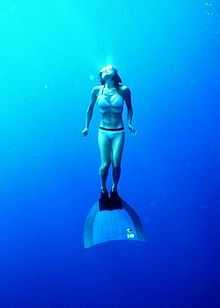Monofin


A monofin is a type of swimfin typically used in underwater sports such as finswimming, free-diving and underwater orienteering. It consists of a single surface attached to footpockets for both of the diver's feet. The diver's appearance is then reminiscent of a mermaid or merman.
The arrival of the monofin in the early 1970s led to the breaking of all world records by the end of the decade due to the improved performance possible when used in lieu of bi-fins.[1]
History and production
Monofins were introduced in 1972 by a Ukrainian finswimming club and have been used for finswimming competitions since, allowing monofin swimmers to reach speeds of 12 km/h.
Monofins can be made of glass fiber or carbon fiber. The diver's muscle power, swimming style, and the type of aquatic activity the monofin is used for determines the choice of size, stiffness, and materials.
Uses
To differentiate between the use of monofins and conventional fins, the latter are sometimes referred to as stereo fins or bi-fins. The monofin swimmer extends arms forward, locking hands together, locking the head between the biceps. The undulating movement starts in the shoulders, with maximum amplitude towards the hips, the legs almost don't bend to transfer the movement to the monofin. This technique is called the dolphin kick.
By slowly oscillating the surface of the monofin when submerged, divers can generate large amounts of thrust even with small or slow movements. This preserves energy which helps when breathholding (apnea).
See also
References
- ↑ "Finswimming". Official site dedicated to Luigi Ferraro. Retrieved 3 December 2013.
External links
| |||||||||||||||||||||||||||||||||||||||||||||